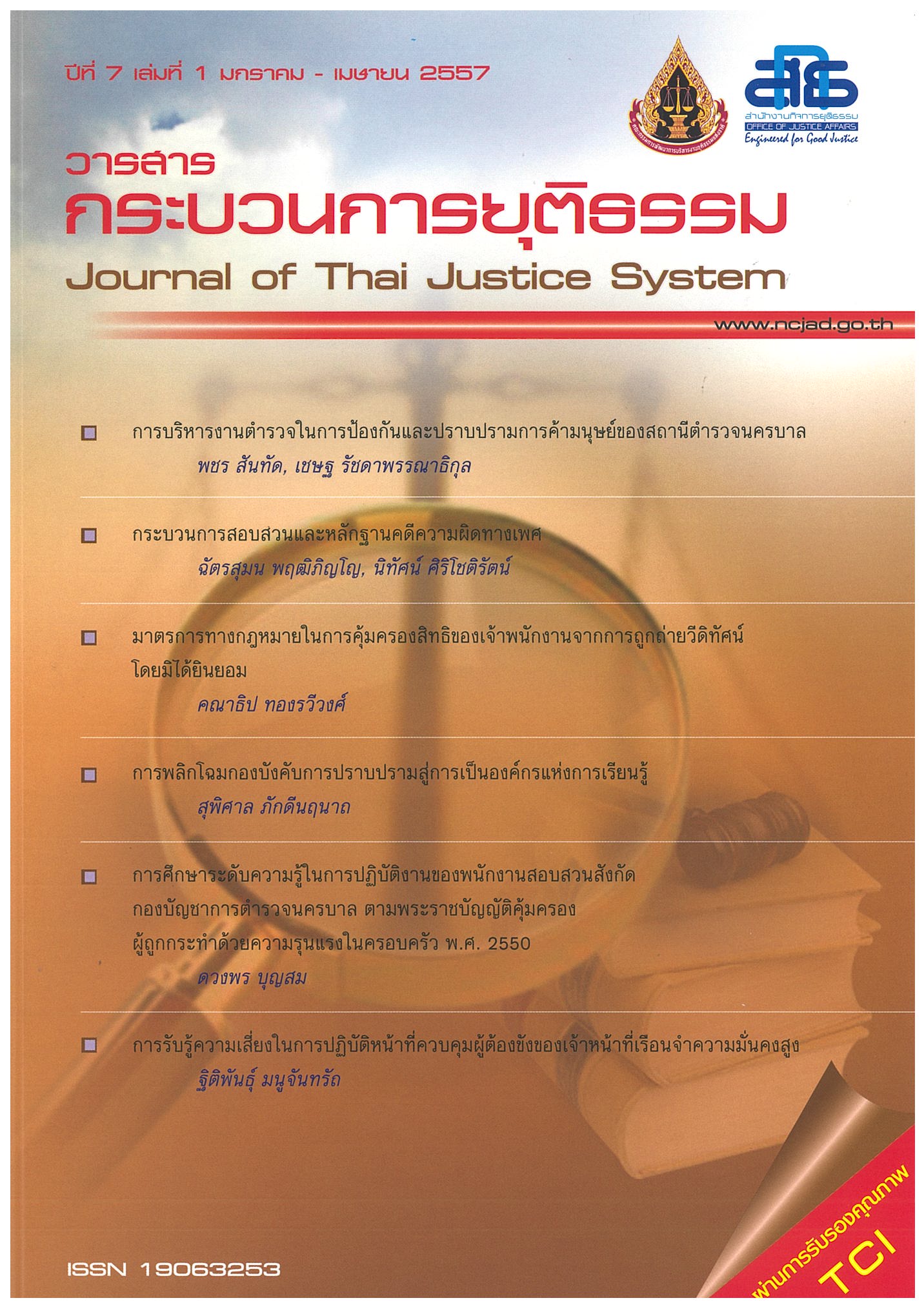กระบวนการสอบสวนและหลักฐานคดีความผิดทางเพศ
Main Article Content
Abstract
Objectives for this research are: to study the sexual crimes' legal practice of police's investigation, and to study investigative procedure. THis is a qualitative research through interviews and analyzing secondary forensic data. Data was collected purposively from 2 police officers responsible for investigations in each police station in metropolitan Bangkok area.
Result indicated that 3 groups of authorities were involved in investigating sexual crimes: 1) investigation police officer, 2) Forensic medical officer, and 3) Official rescue team. Sexual offense investigative team needs to rush to the crime scene and police officer should gather evidences as much as possible such as 1) physically check the victim's body, after receiving the consent, and/or physically check the suspect's body, 2) serach for possession of illegal object, according to search warrant/protocol, 3) subpoena individual who may have/possess objects who may be a potential witness or the object can be used for evidence. In some cases which may require forensic evidences to prove that crime has been committed investigative officer has authority to identify individual, object, or document, through scientific procedure. In case of sexual offensive crime, precautions for each stops/procedure has to be followed carefully and can not violate legal protocol.
Recommendations from this study suggest that at the investigative level, majority of officers who gather eveidences are mostly male, therefore, more female officers should included in the investigative team. At the court of justice level, the process of the sexual offensive crime should not be tried in an open court, and should be conducted the same with child witness protocol.
Article Details
Published Manuscripts are the copyright of the Journal of the Justice System. However; the opinions that appeared in the content are the sole responsibility of the author.
References
ณัฐ ตันศรีสวัสดิ์, ธีรโชติ จองสกุล, อุดมศักดิ์ หุ่นวิจิตร, ภาณุวัตน์ ชุติวงศ์, กรเกียรติ วงษ์ไพศาลสิน, เกษณี จงประสาธ์สุข, และ คนอื่นๆ. (2551). แนวทางปฏิบัติในการตรวจผู้ป่วยที่ถูกล่วงละเมิดทางเพศ. วารสารนิติเวชศาสตร์. 1(3), 11-13
ทีมข่าวอาชญากรรม (2554, 12 กรกฎาคม). ฎีกาประหารชีวิต "ไอ้เต่า" ฆ่าข่มขืนชิงทรัพย์ ม.4 . เดลินิวส์.
ธัญญา ใจดี. (2552, 2 พฤษภาคม). คอลัมฯ์ เสียงสตรี. โพสต์ทูเดย์. 2 - 4.
นพคุณ กีรติการกุล. (2554). นิติวิทยาศาสตร์กับอาชญากรรม. ค้นเมื่อ 22 กรกฎาคม 2554, จาก http://www.scdc5.forensic.police.go.th/article1.htm
พัฒนา กิจไกรลาศ. (2533). ตำแหน่งที่ควรป้ายเก็บของเหลวในช่องคลอดเพื่อตรวจพิสูจน์น้ำอสุจิ รายงานวิจัย มหาวิทยาลัยสงขลานครินทร์.
ศุภกร กันทาลักษณ์. (2522). การสืบสวนทางนิติวิทยาศาสต์. ค้นเมื่อ 10 ตุลาคม 2555, จาก http://www.oknation.net
สมชาย ปรีชาศิลปกุล. (2549). ฐานคติเรื่องเพศวิถีในคำพิพากษา. กรุงเทพฯ: มหาวิทยาลัยเชียงใหม่, คณะนิติศาสตร์ มหาวิทยาลัยเชียงใหม่
สันติ์ สุขวัจน์. (2550). เอกสารคำสอนวิชา พิสูจน์หลักฐาน 1.หน้า 15-16
เอก อังสานนท์. (2550). การสืบสวนและสวบสวน Criminal PRocess LW 443 (พิมพ์ครั้งที่ 2). กรุงเทพมหานาคร:มหาวิทยาลัยรามคำแหง.
Bohm, R. M., & Haley, K N. (2005). Introduction to criminal justice. (4th ed.). New York: McGraw-Hill.
Gardner, T. J., & Anderson, T. M. (2009). Criminal law.the. (10th ed.). New York. Thomson Learning Academic Resource Center.
RAINN: The nation's Largest anti-sexual violence organization. What is Rape Kit?. Accessed at website http://www.rainn.org/get-information/sexual-assault-recovery/rape-kit.
SIO Corner. (2012, 14 March). The TIE Process (Trace/Interview/Eliminate). Courtesy of Police Oracle. Accessed at website http://www.policeoracle.com/news/Crime/2012/Mar/14/SIO-Corner-The-TIE-Process-(Trace-Interview-Eliminate)_46039.html
National Centre for Policing Excellence. (2006). The Murder Investigation Manual: ACPO Centrex Accessed at website http://www.acpo.police.uk/documents/crime/2006/2006CBANMIM.pdf
UCSC Rape Prevention Education. Accessed at website http://localwiki.net/santacruz/UCSC_Rape_Prevention_Education

